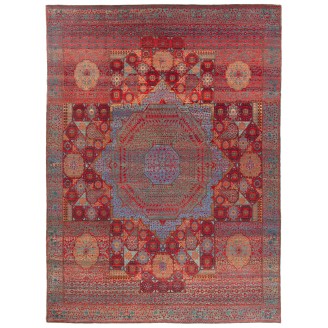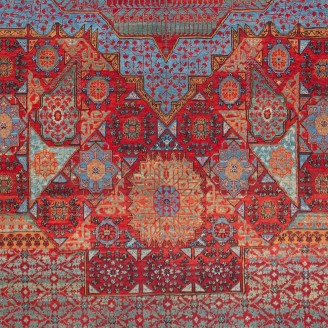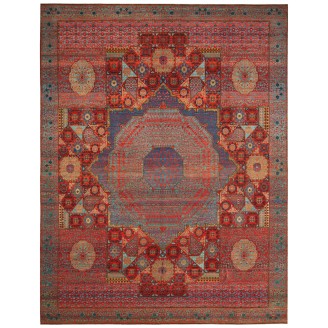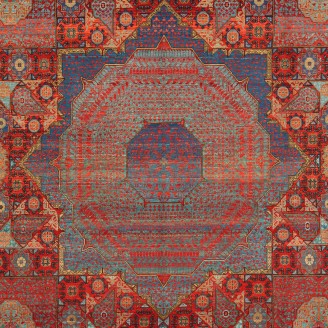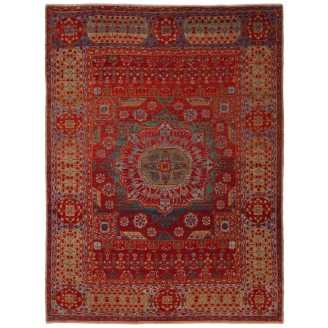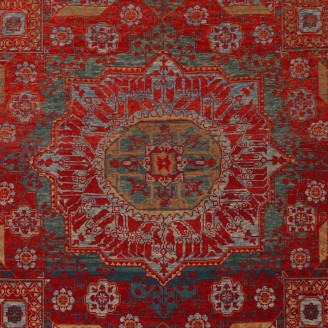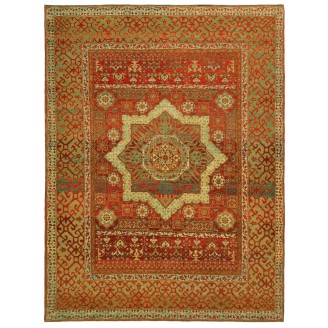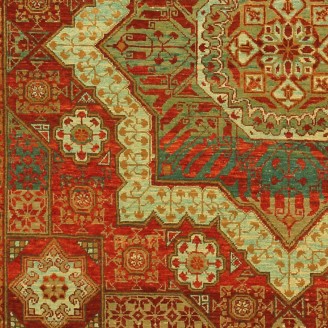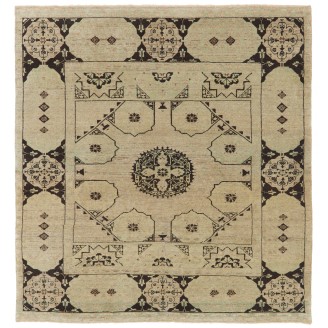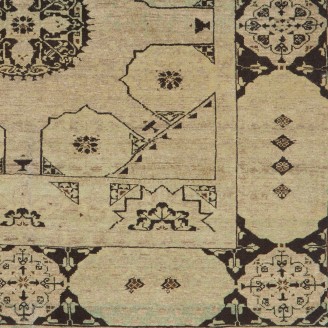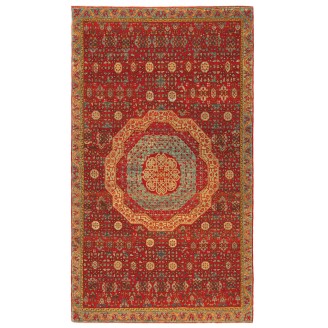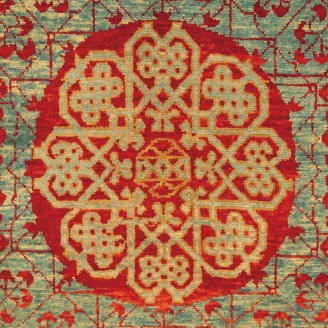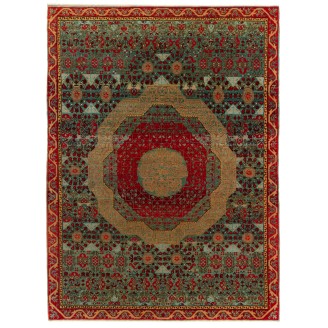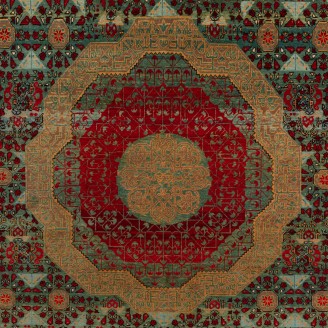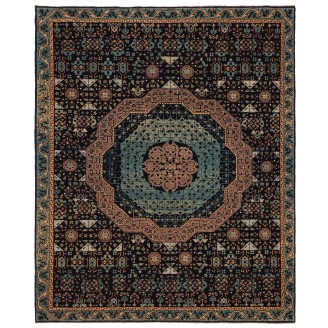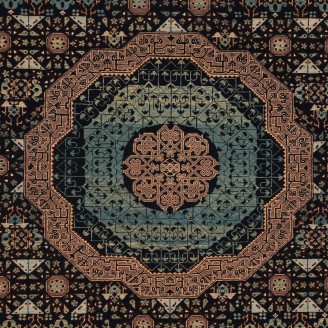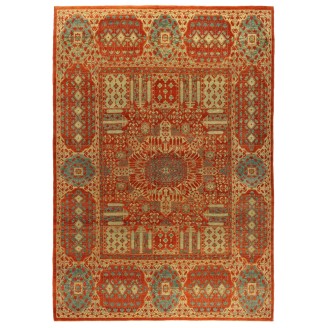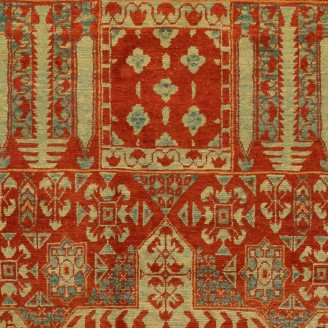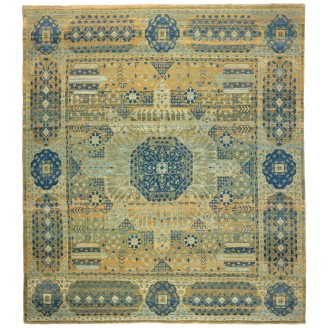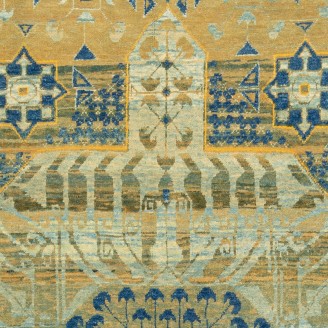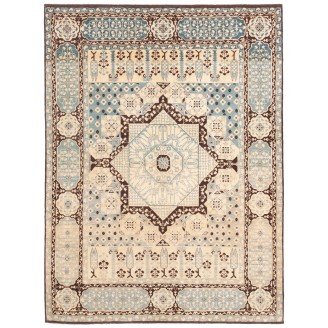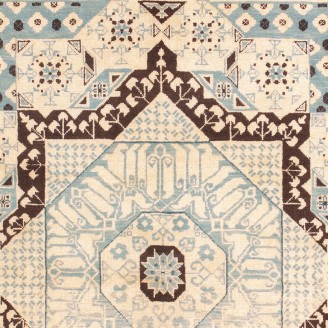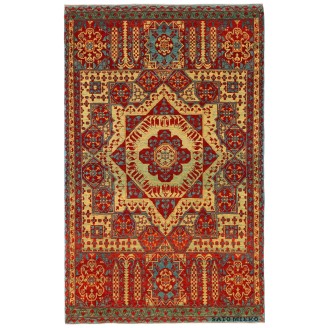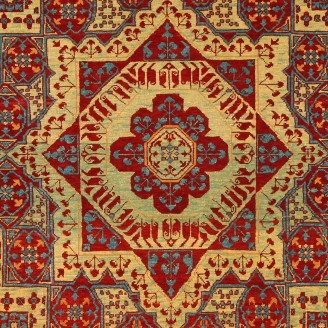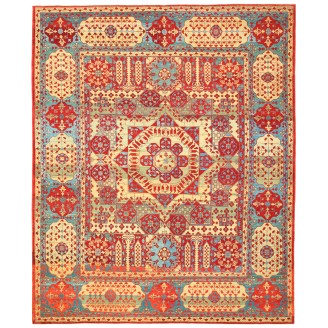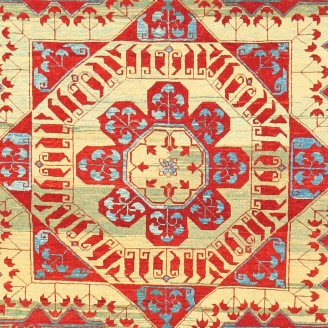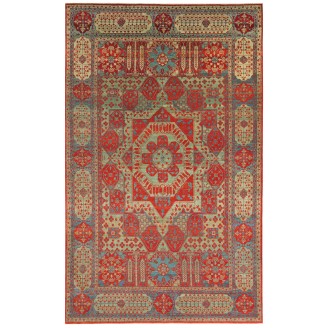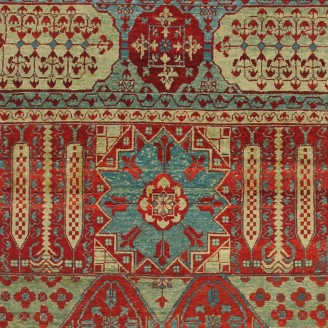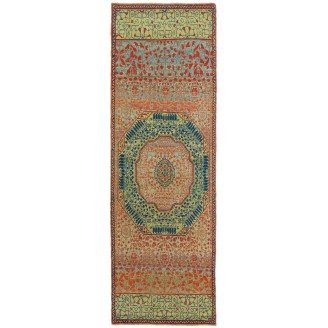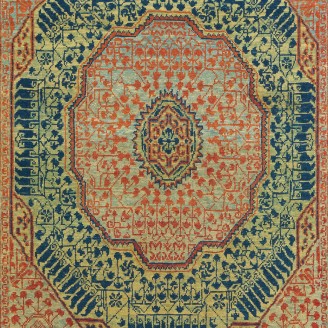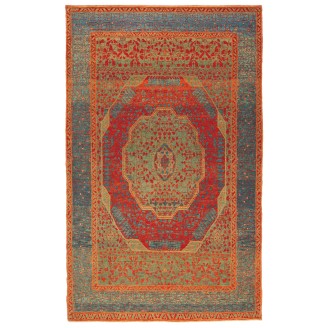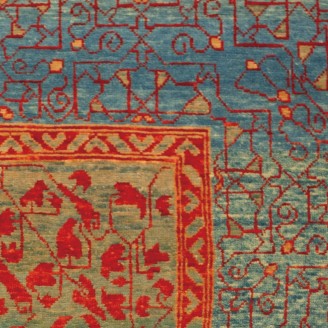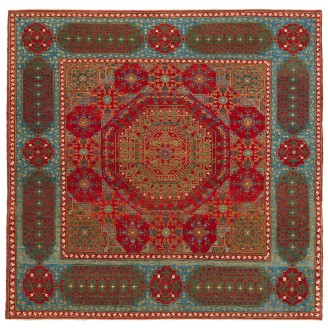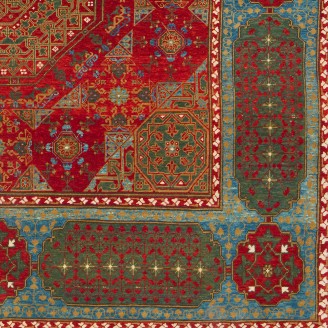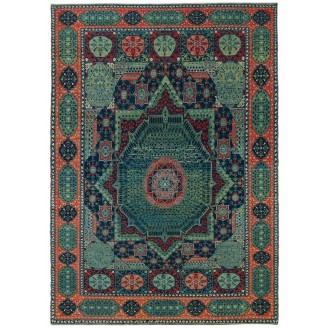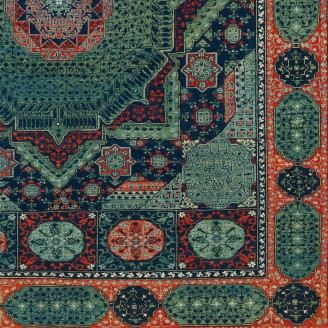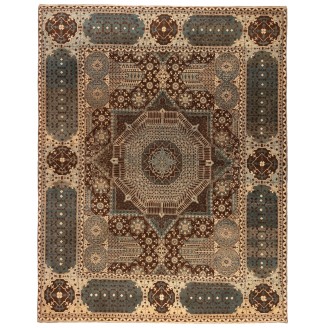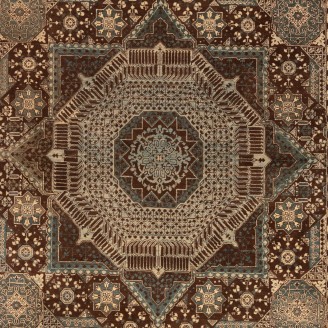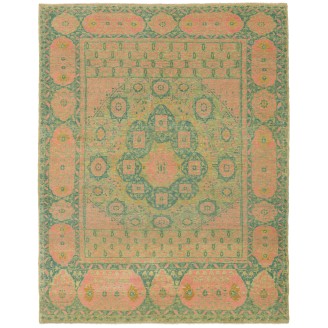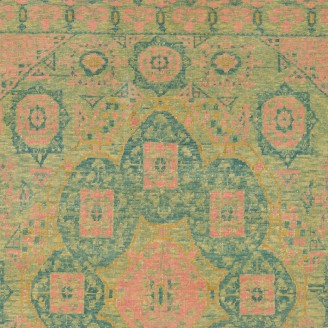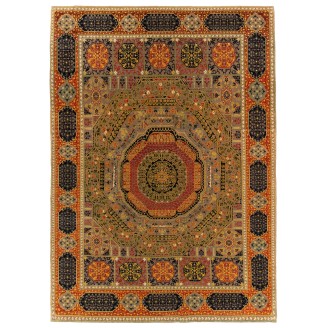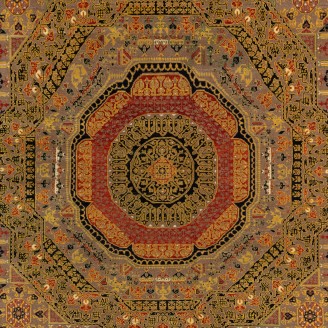COLLECTION OF MAMLOUK RUGS
The Renaissance of Islamic Art. We've brought the 14th-century Mamlouk rugs back to life
Model: ART00036
Dimensions: 8'11" X 12'0"(273cm x 368cm)
The source of the rug comes from the book Völker, Angela, Die orientalischen Knüpfteppiche das MAK, Vienna: Böhlau, 2001: 42–5. This rug with the central star was designed in the early 16th-century rug by Mamluk Sultane of Cairo, Egypt. It is exhibited at MAK – Museum of Applied Arts, Vienna Austria..
Price:
$28,500
Ex Tax:$28,500
Model: ART00038
Dimensions: 8'11" X 11'7"(273cm x 355cm)
The source of the rug comes from the book Völker, Angela, Die orientalischen Knüpfteppiche das MAK, Vienna: Böhlau, 2001: 42–5. This rug with the central star was designed in the early 16th-century rug by Mamluk Sultane of Cairo, Egypt. It is exhibited at MAK – Museum of Applied Arts, Vienna Austria..
Price:
$28,500
Ex Tax:$28,500
Model: ART00056
Dimensions: 5'6" X 7'3"(169cm x 222cm)
The source of the rug comes from the book Renaissance of Islam, Art of the Mamluks, Esin Atil, Smithsonian Institution Press, Washington D.C., 1981 nr.127. This rug with the central star was designed in the early 16th-century rug by Mamluk Sultane of Cairo, Egypt. It is exhibited at the Washington D..
Price:
$7,400
Ex Tax:$7,400
Model: ART00226
Dimensions: 5'10" X 7'10"(180cm x 240cm)
The source of the rug comes from the possession of Endre Unger, which was sold at Sotheby's in 1992. This rug with the central star was designed in the early 16th-century rug by Mamluk Sultane of Cairo, Egypt. It is one of the most immaculate Mamluk carpets, and the medallion stands uncluttered on a..
Price:
$0
Ex Tax:$0
Model: ART00332
Dimensions: 4'10" X 5'1"(148cm x 157cm)
The source of the rug comes from the book Renaissance of Islam, Art of the Mamluks, Esin Atil, Smithsonian Institution Press, Washington D.C., 1981 nr.125. This a rug with a cup motif design, a late 15th-century rug from Mamluk Sultane of Cairo, Egypt. It is exhibited at the Washington D.C. The..
Price:
$4,030
Ex Tax:$4,030
Model: ART00146
Dimensions: 5'0" X 8'9"(154cm x 267cm)
The design source of the rug comes from The C. L. David Collection, Copenhagen. This rug with the Cusped Medallion was designed in the early 16th-century rug by Mamluk Sultane of Cairo, Egypt. Once in the Hirth Collection, and later with Ulrich Schürmann in 1965, this piece now belongs to the David ..
Price:
$7,100
Ex Tax:$7,100
Model: ART00338
Dimensions: 4'11" X 6'9"(152cm x 206cm)
The design source of the rug comes from The C. L. David Collection, Copenhagen. This rug with the Cusped Medallion was designed in the early 16th-century rug by Mamluk Sultane of Cairo, Egypt. Once in the Hirth Collection, and later with Ulrich Schürmann in 1965, this piece now belongs to the David ..
Price:
$5,400
Ex Tax:$5,400
Model: ART00378
Dimensions: 5'1" X 6'1"(156cm x 187cm)
The design source of the rug comes from The C. L. David Collection, Copenhagen. This rug with the Cusped Medallion was designed in the early 16th-century rug by Mamluk Sultane of Cairo, Egypt. Once in the Hirth Collection, and later with Ulrich Schürmann in 1965, this piece now belongs to the David ..
Price:
$5,300
Ex Tax:$5,300
Model: ART00139
Dimensions: 6'9" X 9'10"(208cm x 300cm)
The source of the rug comes from the Herrmann Collection. This rug with the Medici Medallion was designed in the early 16th-century rug by Mamluk Sultane of Cairo, Egypt. Only one other rug closely resembles the Medici Carpet, discovered in 1983 by Alberto Boralevi in the Pitti Palace, Florence, the..
Price:
$0
Ex Tax:$0
Model: ART00041
Dimensions: 8'2" X 9'3"(250cm x 283cm)
The source of the rug comes from the Herrmann Collection. This rug with the Medici Medallion was designed in the early 16th-century rug by Mamluk Sultane of Cairo, Egypt. Only one other rug closely resembles the Medici Carpet, discovered in 1983 by Alberto Boralevi in the Pitti Palace, Florence, the..
Price:
$21,000
Ex Tax:$21,000
Model: ART00018
Dimensions: 5'2" X 7'0"(160cm x 214cm)
The source of the rug comes from the book Renaissance of Islam, Art of the Mamluks, Esin Atil, Smithsonian Institution Press, Washington D.C., 1981 nr.126. This rug with palm trees and cypresses was designed in the late 15th-century rug by Mamluk Sultane of Cairo, Egypt. It is exhibited at the Washi..
Price:
$9,900
Ex Tax:$9,900
Model: ART00235
Dimensions: 3'3" X 5'1"(100cm x 157cm)
The source of the rug comes from the book Renaissance of Islam, Art of the Mamluks, Esin Atil, Smithsonian Institution Press, Washington D.C., 1981 nr.126. This rug with palm trees and cypresses was designed in the late 15th-century rug by Mamluk Sultane of Cairo, Egypt. It is exhibited at the Washi..
Price:
$0
Ex Tax:$0
Model: ART00042
Dimensions: 8'7" X 10'5"(263cm x 320cm)
The source of the rug comes from the book Renaissance of Islam, Art of the Mamluks, Esin Atil, Smithsonian Institution Press, Washington D.C., 1981 nr.126. This rug with palm trees and cypresses was designed in the late 15th-century rug by Mamluk Sultane of Cairo, Egypt. It is exhibited at the Washi..
Price:
$24,000
Ex Tax:$24,000
Model: ART00029
Dimensions: 6'5" X 10'4"(198cm x 316cm)
The source of the rug comes from the book Renaissance of Islam, Art of the Mamluks, Esin Atil, Smithsonian Institution Press, Washington D.C., 1981 nr.126. This rug with palm trees and cypresses was designed in the late 15th-century rug by Mamluk Sultane of Cairo, Egypt. It is exhibited at the Washi..
Price:
$16,500
Ex Tax:$16,500
Model: ART00271
Dimensions: 2'6" X 7'7"(77cm x 233cm)
The source of rug comes from the Jerrehian Collection of Oriental weavings. This rug with the unusual border was designed in the early 16th-century rug by Mamluk Sultane of Cairo, Egypt. The border initially appears to be a complex, geometric interlacing. The most common Mamluk border is one with al..
Price:
$2,900
Ex Tax:$2,900
Model: ART00145
Dimensions: 5'2" X 8'4"(160cm x 255cm)
The source of the rug comes from the Jerrehian Collection of Oriental weavings. This rug with the unusual border was designed in the early 16th-century rug by Mamluk Sultane of Cairo, Egypt. The border initially appears to be a complex, geometric interlacing. The most common Mamluk border is one wit..
Price:
$6,900
Ex Tax:$6,900
Model: ART00441
Dimensions: 6'0" X 5'11"(185cm x 182cm)
The source of carpet comes from the book How to Read - Islamic Carpets, Walter B. Denny, The Metropolitan Museum of Art, New York 2014 fig.61,62. The five-star-medallion carpet was designed in the early 16th century by Mamluk Sultane of Cairo, Egypt. It is exhibited at The Metropolitan Museum of Art..
Price:
$6,700
Ex Tax:$6,700
Model: ART00473
Dimensions: 6'7" X 9'3"(202cm x 282cm)
The source of carpet comes from the book How to Read - Islamic Carpets, Walter B. Denny, The Metropolitan Museum of Art, New York 2014 fig.61,62. The five-star-medallion carpet was designed in the early 16th century by Mamluk Sultane of Cairo, Egypt. It is exhibited at The Metropolitan Museum of Art..
Price:
$10,900
Ex Tax:$10,900
Model: ART00010
Dimensions: 8'2" X 10'4"(250cm x 315cm)
The source of carpet comes from the book How to Read - Islamic Carpets, Walter B. Denny, The Metropolitan Museum of Art, New York 2014 fig.61,62. The five-star-medallion carpet was designed in the early 16th century by Mamluk Sultane of Cairo, Egypt. It is exhibited at The Metropolitan Museum of Art..
Price:
$22,300
Ex Tax:$22,300
Model: ART00337
Dimensions: 5'1" X 6'5"(155cm x 196cm)
The source of carpet comes from the book How to Read - Islamic Carpets, Walter B. Denny, The Metropolitan Museum of Art, New York 2014 fig.61,62. The five-star-medallion carpet was designed in the early 16th century by Mamluk Sultane of Cairo, Egypt. It is exhibited at The Metropolitan Museum of Art..
Price:
$4,860
Ex Tax:$4,860
Model: ART00375
Dimensions: 6'6" X 9'1"(199cm x 277cm)
The source of carpet comes from the book How to Read - Islamic Carpets, Walter B. Denny, The Metropolitan Museum of Art, New York 2014 fig.61,62. The five-star-medallion carpet was designed in the early 16th century by Mamluk Sultane of Cairo, Egypt. It is exhibited at The Metropolitan Museum of Art..
Price:
$9,500
Ex Tax:$9,500
